Angina Pectoris: Clinical Reasoning and Patient Management Essay
VerifiedAdded on 2023/04/22
|14
|3062
|421
Essay
AI Summary
This essay comprehensively examines angina pectoris, a condition characterized by chest pain due to reduced blood flow to the heart. It begins by describing the pathophysiology, including the causes, progression, and potential outcomes of angina, along with associated risk factors such as tobacco use, diabetes, and family history. The essay then explores various treatment options, including beta blockers, nitrates, and antiplatelet medications, and applies these concepts to a patient case. The essay also delves into appropriate physical assessments for patients experiencing angina, excluding vital signs, and discusses three essential nursing interventions to improve physiological outcomes, such as relieving pain, reducing anxiety, and educating the patient on self-care. Additionally, the essay covers the administration of sublingual glyceryl trinitrate, including its benefits, risks, contraindications, and patient education. Finally, the essay reports on major abnormal findings related to the patient's condition and explains the importance of immediate reporting to the doctor.
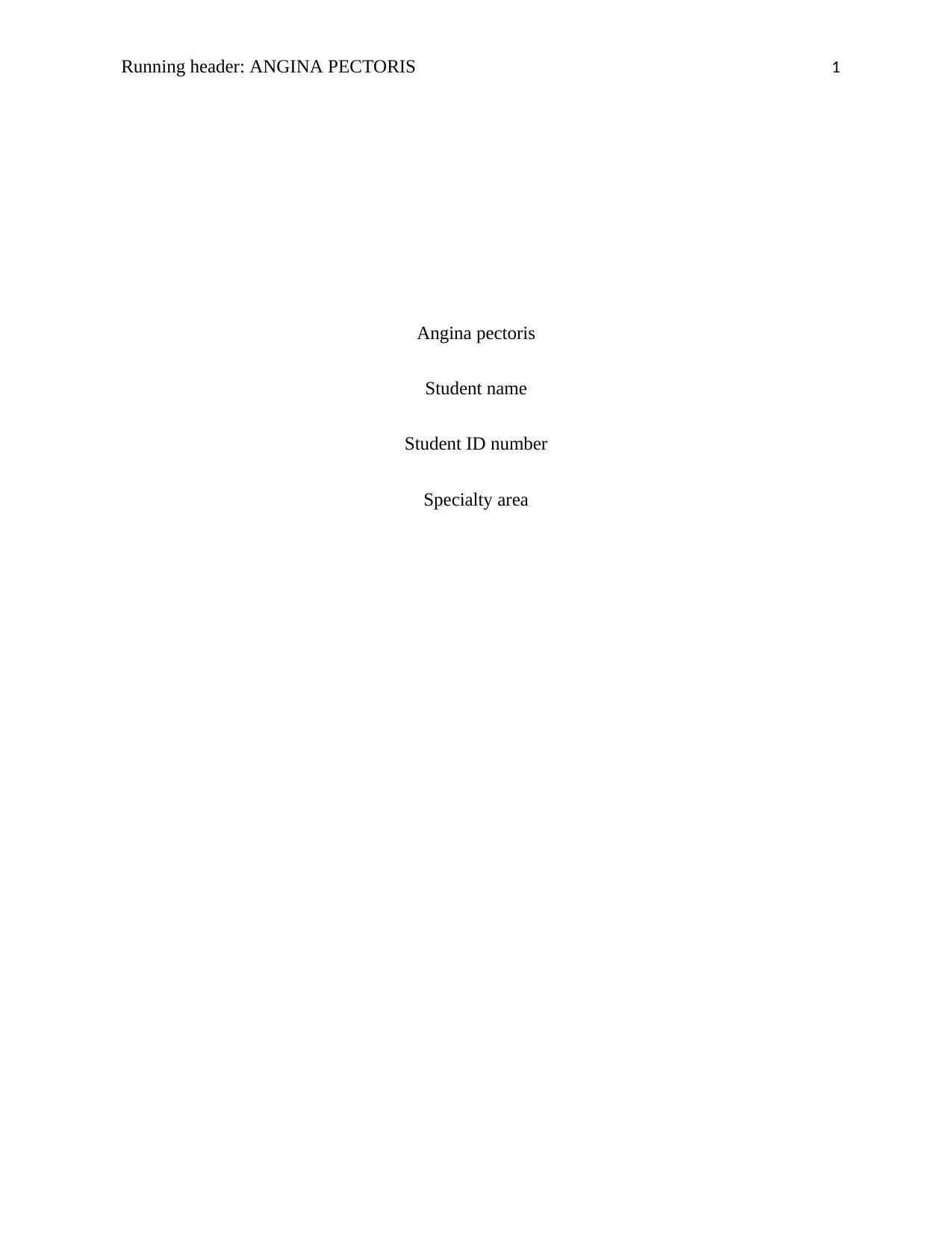
Running header: ANGINA PECTORIS 1
Angina pectoris
Student name
Student ID number
Specialty area
Angina pectoris
Student name
Student ID number
Specialty area
Paraphrase This Document
Need a fresh take? Get an instant paraphrase of this document with our AI Paraphraser
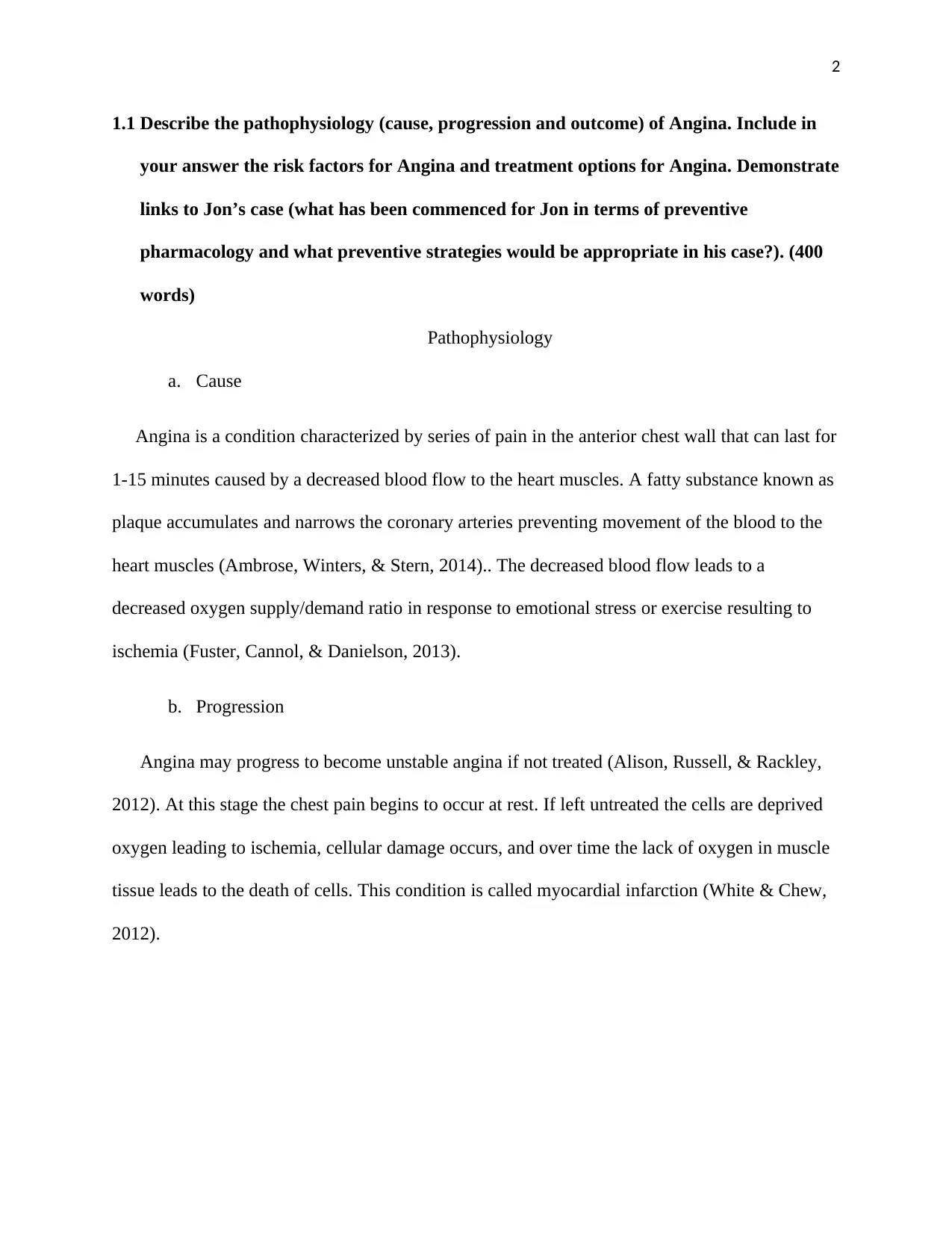
2
1.1 Describe the pathophysiology (cause, progression and outcome) of Angina. Include in
your answer the risk factors for Angina and treatment options for Angina. Demonstrate
links to Jon’s case (what has been commenced for Jon in terms of preventive
pharmacology and what preventive strategies would be appropriate in his case?). (400
words)
Pathophysiology
a. Cause
Angina is a condition characterized by series of pain in the anterior chest wall that can last for
1-15 minutes caused by a decreased blood flow to the heart muscles. A fatty substance known as
plaque accumulates and narrows the coronary arteries preventing movement of the blood to the
heart muscles (Ambrose, Winters, & Stern, 2014).. The decreased blood flow leads to a
decreased oxygen supply/demand ratio in response to emotional stress or exercise resulting to
ischemia (Fuster, Cannol, & Danielson, 2013).
b. Progression
Angina may progress to become unstable angina if not treated (Alison, Russell, & Rackley,
2012). At this stage the chest pain begins to occur at rest. If left untreated the cells are deprived
oxygen leading to ischemia, cellular damage occurs, and over time the lack of oxygen in muscle
tissue leads to the death of cells. This condition is called myocardial infarction (White & Chew,
2012).
1.1 Describe the pathophysiology (cause, progression and outcome) of Angina. Include in
your answer the risk factors for Angina and treatment options for Angina. Demonstrate
links to Jon’s case (what has been commenced for Jon in terms of preventive
pharmacology and what preventive strategies would be appropriate in his case?). (400
words)
Pathophysiology
a. Cause
Angina is a condition characterized by series of pain in the anterior chest wall that can last for
1-15 minutes caused by a decreased blood flow to the heart muscles. A fatty substance known as
plaque accumulates and narrows the coronary arteries preventing movement of the blood to the
heart muscles (Ambrose, Winters, & Stern, 2014).. The decreased blood flow leads to a
decreased oxygen supply/demand ratio in response to emotional stress or exercise resulting to
ischemia (Fuster, Cannol, & Danielson, 2013).
b. Progression
Angina may progress to become unstable angina if not treated (Alison, Russell, & Rackley,
2012). At this stage the chest pain begins to occur at rest. If left untreated the cells are deprived
oxygen leading to ischemia, cellular damage occurs, and over time the lack of oxygen in muscle
tissue leads to the death of cells. This condition is called myocardial infarction (White & Chew,
2012).
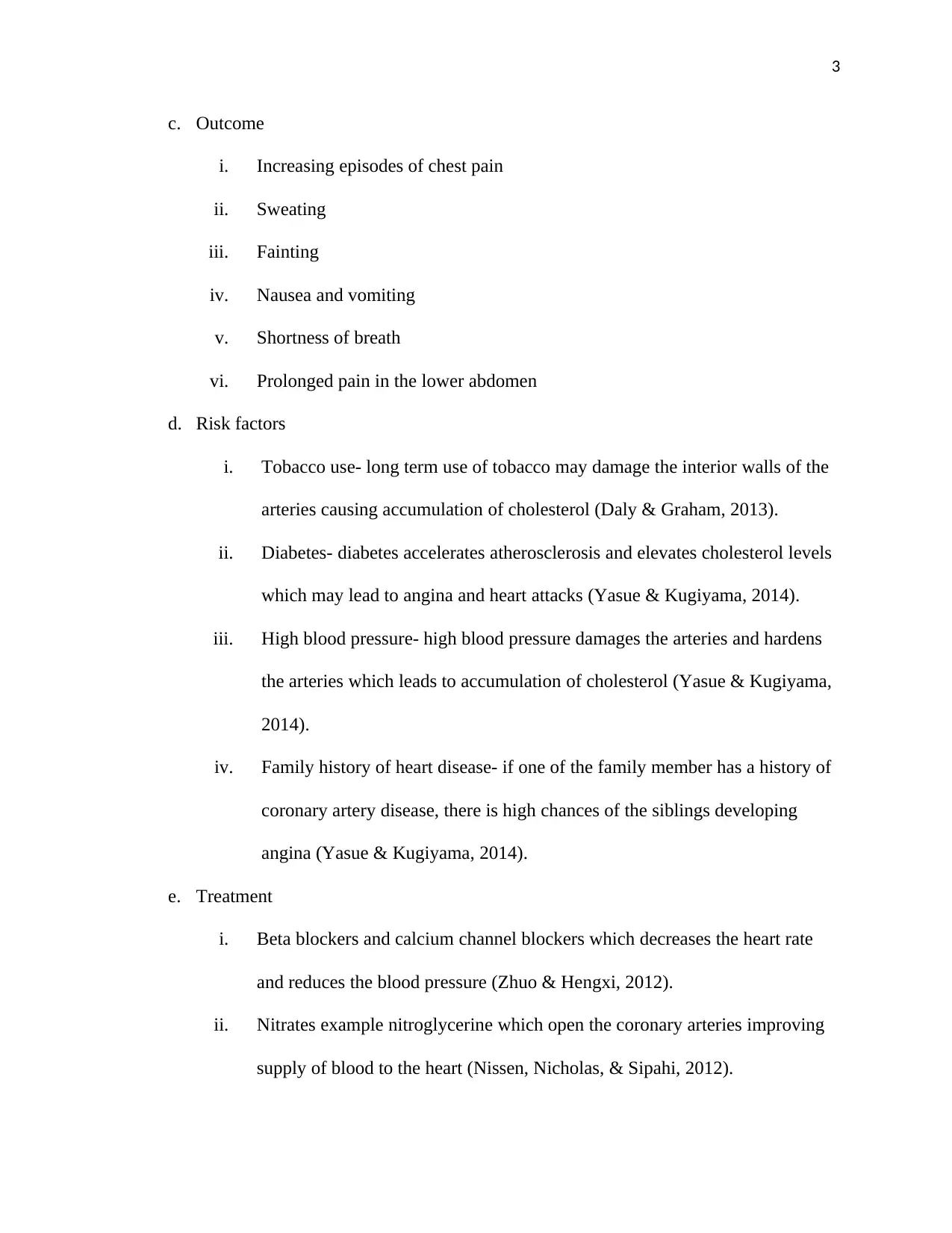
3
c. Outcome
i. Increasing episodes of chest pain
ii. Sweating
iii. Fainting
iv. Nausea and vomiting
v. Shortness of breath
vi. Prolonged pain in the lower abdomen
d. Risk factors
i. Tobacco use- long term use of tobacco may damage the interior walls of the
arteries causing accumulation of cholesterol (Daly & Graham, 2013).
ii. Diabetes- diabetes accelerates atherosclerosis and elevates cholesterol levels
which may lead to angina and heart attacks (Yasue & Kugiyama, 2014).
iii. High blood pressure- high blood pressure damages the arteries and hardens
the arteries which leads to accumulation of cholesterol (Yasue & Kugiyama,
2014).
iv. Family history of heart disease- if one of the family member has a history of
coronary artery disease, there is high chances of the siblings developing
angina (Yasue & Kugiyama, 2014).
e. Treatment
i. Beta blockers and calcium channel blockers which decreases the heart rate
and reduces the blood pressure (Zhuo & Hengxi, 2012).
ii. Nitrates example nitroglycerine which open the coronary arteries improving
supply of blood to the heart (Nissen, Nicholas, & Sipahi, 2012).
c. Outcome
i. Increasing episodes of chest pain
ii. Sweating
iii. Fainting
iv. Nausea and vomiting
v. Shortness of breath
vi. Prolonged pain in the lower abdomen
d. Risk factors
i. Tobacco use- long term use of tobacco may damage the interior walls of the
arteries causing accumulation of cholesterol (Daly & Graham, 2013).
ii. Diabetes- diabetes accelerates atherosclerosis and elevates cholesterol levels
which may lead to angina and heart attacks (Yasue & Kugiyama, 2014).
iii. High blood pressure- high blood pressure damages the arteries and hardens
the arteries which leads to accumulation of cholesterol (Yasue & Kugiyama,
2014).
iv. Family history of heart disease- if one of the family member has a history of
coronary artery disease, there is high chances of the siblings developing
angina (Yasue & Kugiyama, 2014).
e. Treatment
i. Beta blockers and calcium channel blockers which decreases the heart rate
and reduces the blood pressure (Zhuo & Hengxi, 2012).
ii. Nitrates example nitroglycerine which open the coronary arteries improving
supply of blood to the heart (Nissen, Nicholas, & Sipahi, 2012).
⊘ This is a preview!⊘
Do you want full access?
Subscribe today to unlock all pages.

Trusted by 1+ million students worldwide
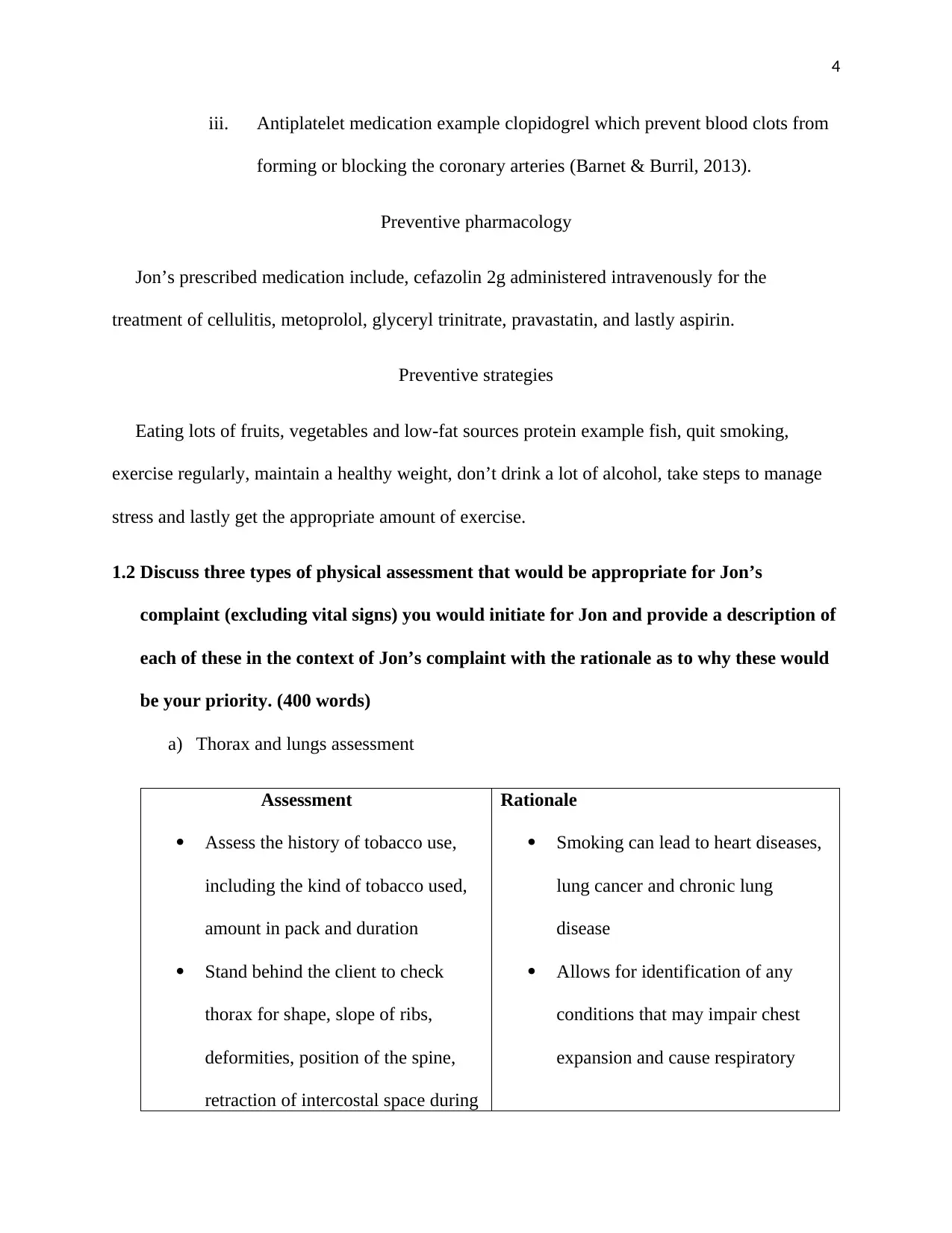
4
iii. Antiplatelet medication example clopidogrel which prevent blood clots from
forming or blocking the coronary arteries (Barnet & Burril, 2013).
Preventive pharmacology
Jon’s prescribed medication include, cefazolin 2g administered intravenously for the
treatment of cellulitis, metoprolol, glyceryl trinitrate, pravastatin, and lastly aspirin.
Preventive strategies
Eating lots of fruits, vegetables and low-fat sources protein example fish, quit smoking,
exercise regularly, maintain a healthy weight, don’t drink a lot of alcohol, take steps to manage
stress and lastly get the appropriate amount of exercise.
1.2 Discuss three types of physical assessment that would be appropriate for Jon’s
complaint (excluding vital signs) you would initiate for Jon and provide a description of
each of these in the context of Jon’s complaint with the rationale as to why these would
be your priority. (400 words)
a) Thorax and lungs assessment
Assessment
Assess the history of tobacco use,
including the kind of tobacco used,
amount in pack and duration
Stand behind the client to check
thorax for shape, slope of ribs,
deformities, position of the spine,
retraction of intercostal space during
Rationale
Smoking can lead to heart diseases,
lung cancer and chronic lung
disease
Allows for identification of any
conditions that may impair chest
expansion and cause respiratory
iii. Antiplatelet medication example clopidogrel which prevent blood clots from
forming or blocking the coronary arteries (Barnet & Burril, 2013).
Preventive pharmacology
Jon’s prescribed medication include, cefazolin 2g administered intravenously for the
treatment of cellulitis, metoprolol, glyceryl trinitrate, pravastatin, and lastly aspirin.
Preventive strategies
Eating lots of fruits, vegetables and low-fat sources protein example fish, quit smoking,
exercise regularly, maintain a healthy weight, don’t drink a lot of alcohol, take steps to manage
stress and lastly get the appropriate amount of exercise.
1.2 Discuss three types of physical assessment that would be appropriate for Jon’s
complaint (excluding vital signs) you would initiate for Jon and provide a description of
each of these in the context of Jon’s complaint with the rationale as to why these would
be your priority. (400 words)
a) Thorax and lungs assessment
Assessment
Assess the history of tobacco use,
including the kind of tobacco used,
amount in pack and duration
Stand behind the client to check
thorax for shape, slope of ribs,
deformities, position of the spine,
retraction of intercostal space during
Rationale
Smoking can lead to heart diseases,
lung cancer and chronic lung
disease
Allows for identification of any
conditions that may impair chest
expansion and cause respiratory
Paraphrase This Document
Need a fresh take? Get an instant paraphrase of this document with our AI Paraphraser

5
expiration and lastly bulging of
intercostal space during expiration
(Massey & Maredith, 2012).
Stand behind the client, place the
thumbs along the spinal process at
the tenth rib, with the palms lightly
contacting the posterolateral
surfaces. Press the hands towards the
clients spine to form small skinfold
between the thumbs. Note the
movement of the thumbs and note
the symmetry of the chest wall
movement (Massey & Maredith,
2012).
distress
Palpation of chest excursion
assesses depth of clients breathing.
This techniques is good measure to
evaluate client’s ability to perform
deep breathing exercise. Limited
movement at one side may indicate
that the client is voluntarily
splinting during ventilation because
of pain.
b) Heart and neck vessel assessment
Assessment
Determine if the client is taking
medication for cardiovascular
function and if the client knows
the dosage, purpose and side
effects (Baid, 2014)
Rationale
This allows the nurse to assess
client’s compliance with and
understanding of the drug
therapies. Medication for
cardiovascular function cannot
be taken intermittently (Baid,
expiration and lastly bulging of
intercostal space during expiration
(Massey & Maredith, 2012).
Stand behind the client, place the
thumbs along the spinal process at
the tenth rib, with the palms lightly
contacting the posterolateral
surfaces. Press the hands towards the
clients spine to form small skinfold
between the thumbs. Note the
movement of the thumbs and note
the symmetry of the chest wall
movement (Massey & Maredith,
2012).
distress
Palpation of chest excursion
assesses depth of clients breathing.
This techniques is good measure to
evaluate client’s ability to perform
deep breathing exercise. Limited
movement at one side may indicate
that the client is voluntarily
splinting during ventilation because
of pain.
b) Heart and neck vessel assessment
Assessment
Determine if the client is taking
medication for cardiovascular
function and if the client knows
the dosage, purpose and side
effects (Baid, 2014)
Rationale
This allows the nurse to assess
client’s compliance with and
understanding of the drug
therapies. Medication for
cardiovascular function cannot
be taken intermittently (Baid,
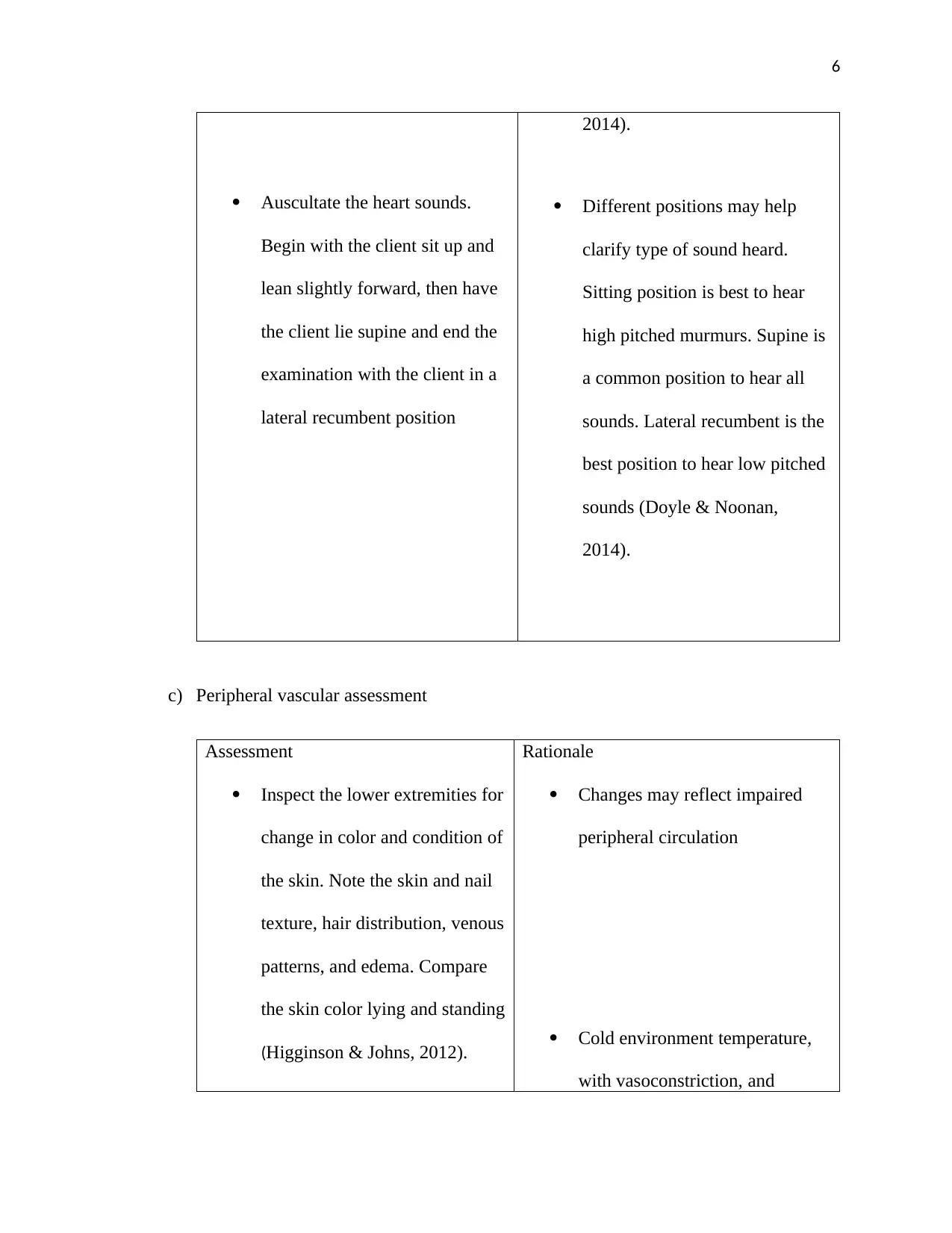
6
Auscultate the heart sounds.
Begin with the client sit up and
lean slightly forward, then have
the client lie supine and end the
examination with the client in a
lateral recumbent position
2014).
Different positions may help
clarify type of sound heard.
Sitting position is best to hear
high pitched murmurs. Supine is
a common position to hear all
sounds. Lateral recumbent is the
best position to hear low pitched
sounds (Doyle & Noonan,
2014).
c) Peripheral vascular assessment
Assessment
Inspect the lower extremities for
change in color and condition of
the skin. Note the skin and nail
texture, hair distribution, venous
patterns, and edema. Compare
the skin color lying and standing
(Higginson & Johns, 2012).
Rationale
Changes may reflect impaired
peripheral circulation
Cold environment temperature,
with vasoconstriction, and
Auscultate the heart sounds.
Begin with the client sit up and
lean slightly forward, then have
the client lie supine and end the
examination with the client in a
lateral recumbent position
2014).
Different positions may help
clarify type of sound heard.
Sitting position is best to hear
high pitched murmurs. Supine is
a common position to hear all
sounds. Lateral recumbent is the
best position to hear low pitched
sounds (Doyle & Noonan,
2014).
c) Peripheral vascular assessment
Assessment
Inspect the lower extremities for
change in color and condition of
the skin. Note the skin and nail
texture, hair distribution, venous
patterns, and edema. Compare
the skin color lying and standing
(Higginson & Johns, 2012).
Rationale
Changes may reflect impaired
peripheral circulation
Cold environment temperature,
with vasoconstriction, and
⊘ This is a preview!⊘
Do you want full access?
Subscribe today to unlock all pages.

Trusted by 1+ million students worldwide
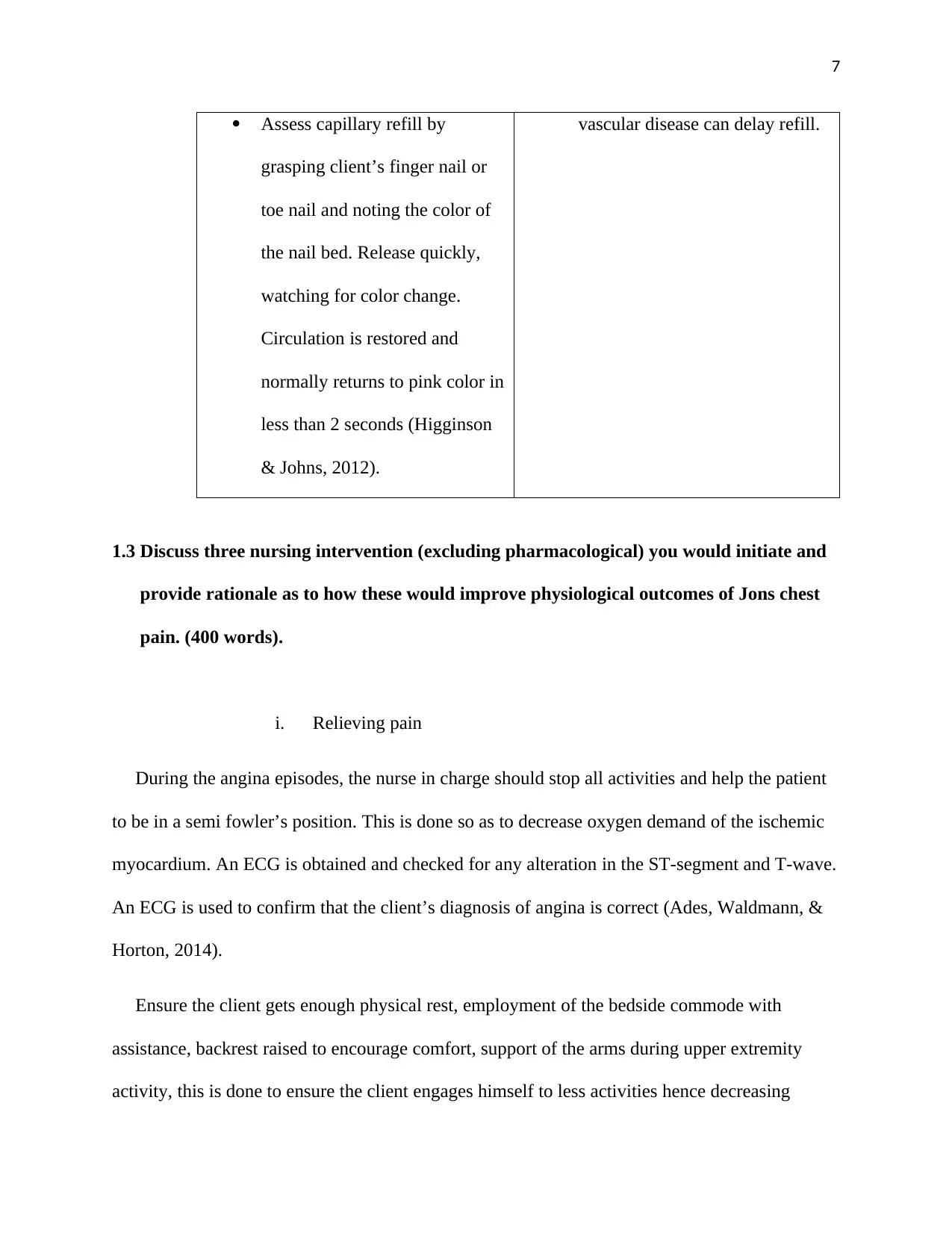
7
Assess capillary refill by
grasping client’s finger nail or
toe nail and noting the color of
the nail bed. Release quickly,
watching for color change.
Circulation is restored and
normally returns to pink color in
less than 2 seconds (Higginson
& Johns, 2012).
vascular disease can delay refill.
1.3 Discuss three nursing intervention (excluding pharmacological) you would initiate and
provide rationale as to how these would improve physiological outcomes of Jons chest
pain. (400 words).
i. Relieving pain
During the angina episodes, the nurse in charge should stop all activities and help the patient
to be in a semi fowler’s position. This is done so as to decrease oxygen demand of the ischemic
myocardium. An ECG is obtained and checked for any alteration in the ST-segment and T-wave.
An ECG is used to confirm that the client’s diagnosis of angina is correct (Ades, Waldmann, &
Horton, 2014).
Ensure the client gets enough physical rest, employment of the bedside commode with
assistance, backrest raised to encourage comfort, support of the arms during upper extremity
activity, this is done to ensure the client engages himself to less activities hence decreasing
Assess capillary refill by
grasping client’s finger nail or
toe nail and noting the color of
the nail bed. Release quickly,
watching for color change.
Circulation is restored and
normally returns to pink color in
less than 2 seconds (Higginson
& Johns, 2012).
vascular disease can delay refill.
1.3 Discuss three nursing intervention (excluding pharmacological) you would initiate and
provide rationale as to how these would improve physiological outcomes of Jons chest
pain. (400 words).
i. Relieving pain
During the angina episodes, the nurse in charge should stop all activities and help the patient
to be in a semi fowler’s position. This is done so as to decrease oxygen demand of the ischemic
myocardium. An ECG is obtained and checked for any alteration in the ST-segment and T-wave.
An ECG is used to confirm that the client’s diagnosis of angina is correct (Ades, Waldmann, &
Horton, 2014).
Ensure the client gets enough physical rest, employment of the bedside commode with
assistance, backrest raised to encourage comfort, support of the arms during upper extremity
activity, this is done to ensure the client engages himself to less activities hence decreasing
Paraphrase This Document
Need a fresh take? Get an instant paraphrase of this document with our AI Paraphraser
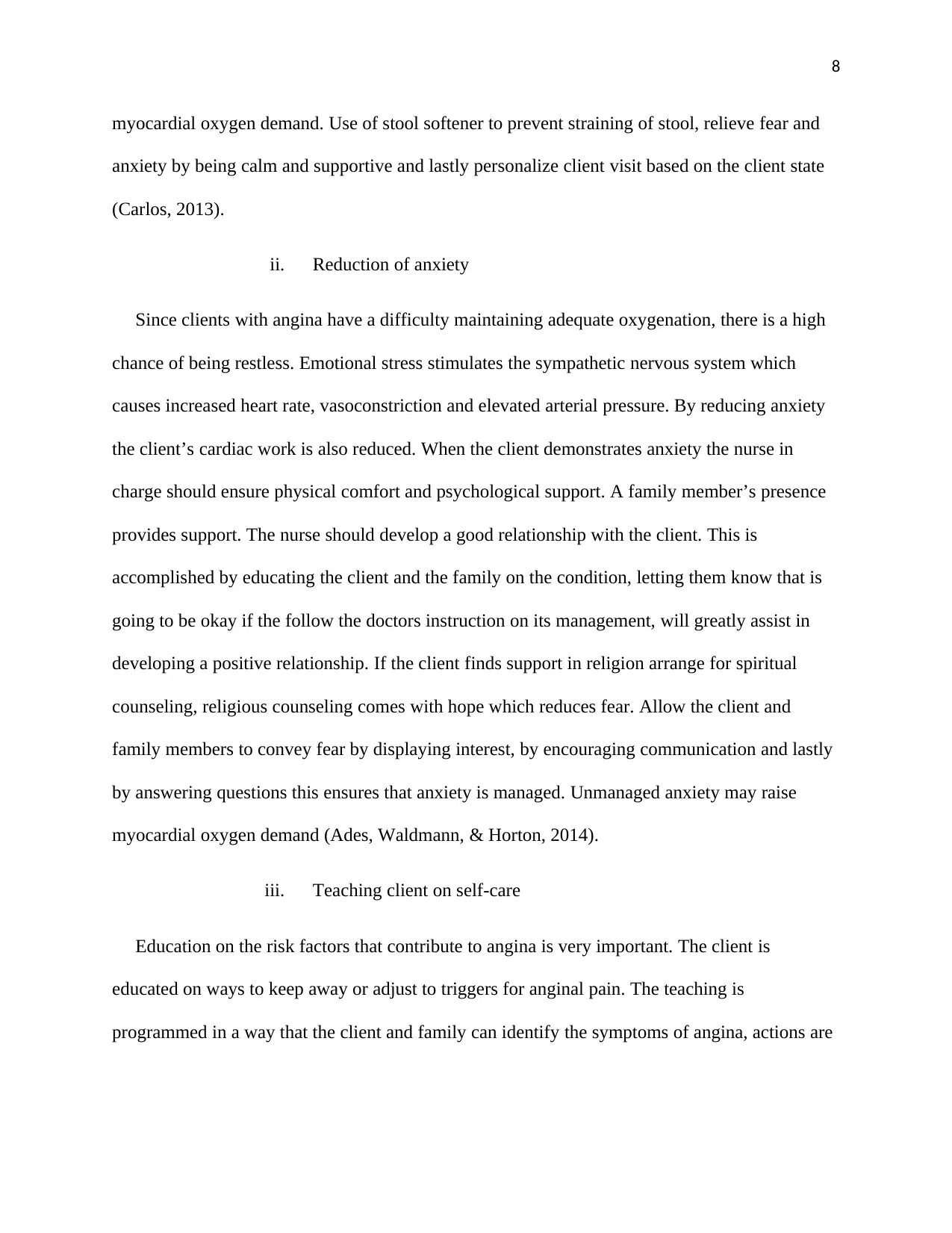
8
myocardial oxygen demand. Use of stool softener to prevent straining of stool, relieve fear and
anxiety by being calm and supportive and lastly personalize client visit based on the client state
(Carlos, 2013).
ii. Reduction of anxiety
Since clients with angina have a difficulty maintaining adequate oxygenation, there is a high
chance of being restless. Emotional stress stimulates the sympathetic nervous system which
causes increased heart rate, vasoconstriction and elevated arterial pressure. By reducing anxiety
the client’s cardiac work is also reduced. When the client demonstrates anxiety the nurse in
charge should ensure physical comfort and psychological support. A family member’s presence
provides support. The nurse should develop a good relationship with the client. This is
accomplished by educating the client and the family on the condition, letting them know that is
going to be okay if the follow the doctors instruction on its management, will greatly assist in
developing a positive relationship. If the client finds support in religion arrange for spiritual
counseling, religious counseling comes with hope which reduces fear. Allow the client and
family members to convey fear by displaying interest, by encouraging communication and lastly
by answering questions this ensures that anxiety is managed. Unmanaged anxiety may raise
myocardial oxygen demand (Ades, Waldmann, & Horton, 2014).
iii. Teaching client on self-care
Education on the risk factors that contribute to angina is very important. The client is
educated on ways to keep away or adjust to triggers for anginal pain. The teaching is
programmed in a way that the client and family can identify the symptoms of angina, actions are
myocardial oxygen demand. Use of stool softener to prevent straining of stool, relieve fear and
anxiety by being calm and supportive and lastly personalize client visit based on the client state
(Carlos, 2013).
ii. Reduction of anxiety
Since clients with angina have a difficulty maintaining adequate oxygenation, there is a high
chance of being restless. Emotional stress stimulates the sympathetic nervous system which
causes increased heart rate, vasoconstriction and elevated arterial pressure. By reducing anxiety
the client’s cardiac work is also reduced. When the client demonstrates anxiety the nurse in
charge should ensure physical comfort and psychological support. A family member’s presence
provides support. The nurse should develop a good relationship with the client. This is
accomplished by educating the client and the family on the condition, letting them know that is
going to be okay if the follow the doctors instruction on its management, will greatly assist in
developing a positive relationship. If the client finds support in religion arrange for spiritual
counseling, religious counseling comes with hope which reduces fear. Allow the client and
family members to convey fear by displaying interest, by encouraging communication and lastly
by answering questions this ensures that anxiety is managed. Unmanaged anxiety may raise
myocardial oxygen demand (Ades, Waldmann, & Horton, 2014).
iii. Teaching client on self-care
Education on the risk factors that contribute to angina is very important. The client is
educated on ways to keep away or adjust to triggers for anginal pain. The teaching is
programmed in a way that the client and family can identify the symptoms of angina, actions are
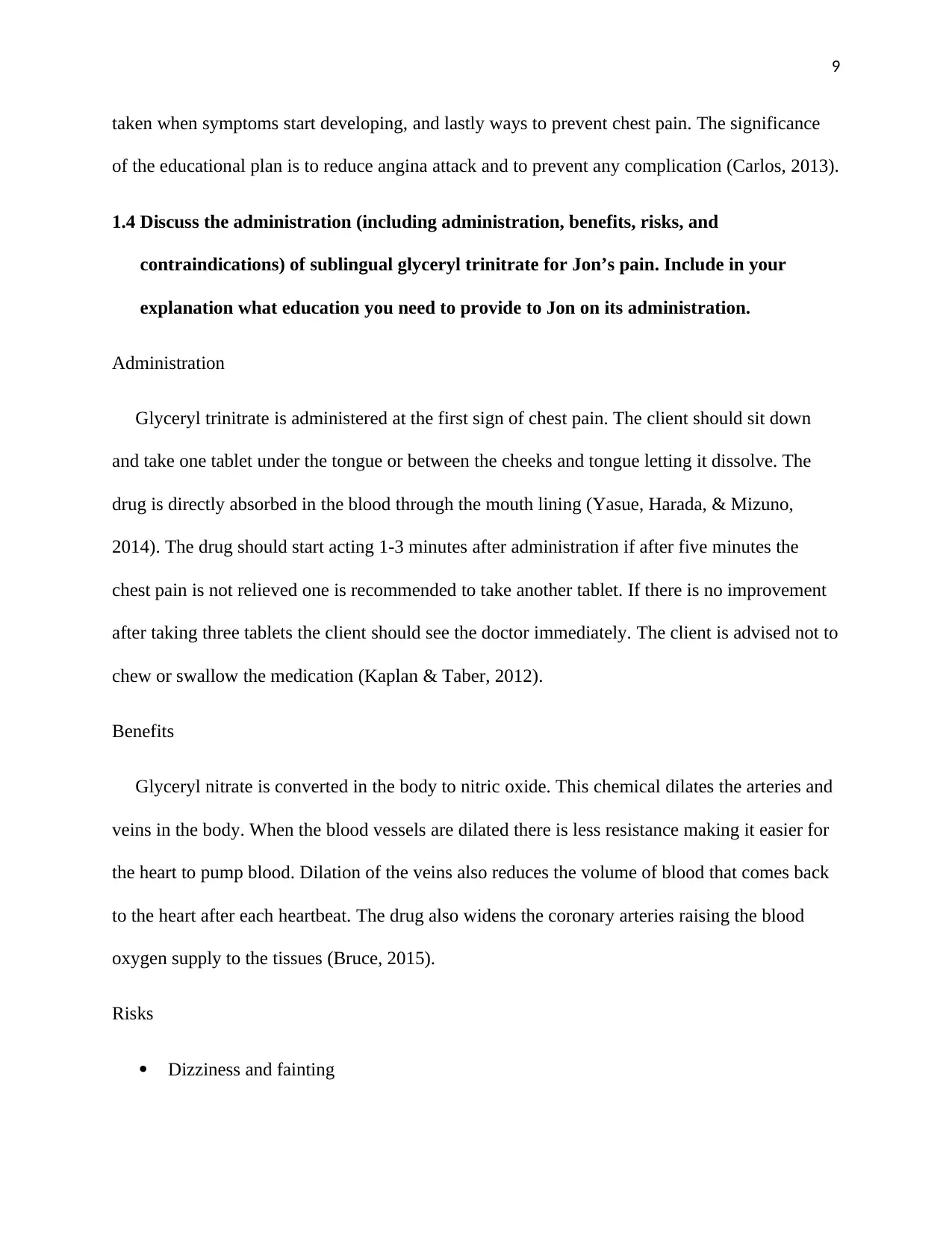
9
taken when symptoms start developing, and lastly ways to prevent chest pain. The significance
of the educational plan is to reduce angina attack and to prevent any complication (Carlos, 2013).
1.4 Discuss the administration (including administration, benefits, risks, and
contraindications) of sublingual glyceryl trinitrate for Jon’s pain. Include in your
explanation what education you need to provide to Jon on its administration.
Administration
Glyceryl trinitrate is administered at the first sign of chest pain. The client should sit down
and take one tablet under the tongue or between the cheeks and tongue letting it dissolve. The
drug is directly absorbed in the blood through the mouth lining (Yasue, Harada, & Mizuno,
2014). The drug should start acting 1-3 minutes after administration if after five minutes the
chest pain is not relieved one is recommended to take another tablet. If there is no improvement
after taking three tablets the client should see the doctor immediately. The client is advised not to
chew or swallow the medication (Kaplan & Taber, 2012).
Benefits
Glyceryl nitrate is converted in the body to nitric oxide. This chemical dilates the arteries and
veins in the body. When the blood vessels are dilated there is less resistance making it easier for
the heart to pump blood. Dilation of the veins also reduces the volume of blood that comes back
to the heart after each heartbeat. The drug also widens the coronary arteries raising the blood
oxygen supply to the tissues (Bruce, 2015).
Risks
Dizziness and fainting
taken when symptoms start developing, and lastly ways to prevent chest pain. The significance
of the educational plan is to reduce angina attack and to prevent any complication (Carlos, 2013).
1.4 Discuss the administration (including administration, benefits, risks, and
contraindications) of sublingual glyceryl trinitrate for Jon’s pain. Include in your
explanation what education you need to provide to Jon on its administration.
Administration
Glyceryl trinitrate is administered at the first sign of chest pain. The client should sit down
and take one tablet under the tongue or between the cheeks and tongue letting it dissolve. The
drug is directly absorbed in the blood through the mouth lining (Yasue, Harada, & Mizuno,
2014). The drug should start acting 1-3 minutes after administration if after five minutes the
chest pain is not relieved one is recommended to take another tablet. If there is no improvement
after taking three tablets the client should see the doctor immediately. The client is advised not to
chew or swallow the medication (Kaplan & Taber, 2012).
Benefits
Glyceryl nitrate is converted in the body to nitric oxide. This chemical dilates the arteries and
veins in the body. When the blood vessels are dilated there is less resistance making it easier for
the heart to pump blood. Dilation of the veins also reduces the volume of blood that comes back
to the heart after each heartbeat. The drug also widens the coronary arteries raising the blood
oxygen supply to the tissues (Bruce, 2015).
Risks
Dizziness and fainting
⊘ This is a preview!⊘
Do you want full access?
Subscribe today to unlock all pages.

Trusted by 1+ million students worldwide
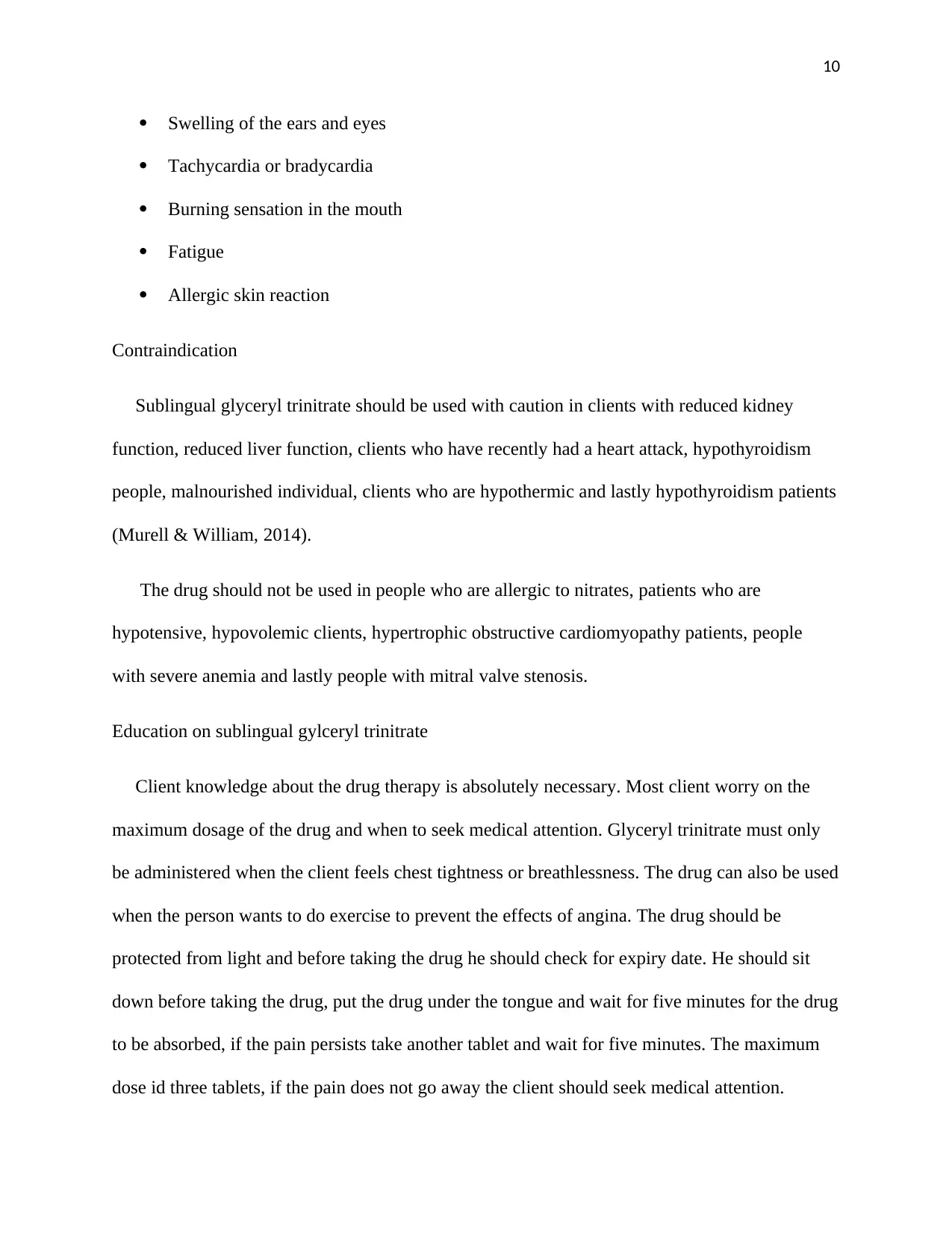
10
Swelling of the ears and eyes
Tachycardia or bradycardia
Burning sensation in the mouth
Fatigue
Allergic skin reaction
Contraindication
Sublingual glyceryl trinitrate should be used with caution in clients with reduced kidney
function, reduced liver function, clients who have recently had a heart attack, hypothyroidism
people, malnourished individual, clients who are hypothermic and lastly hypothyroidism patients
(Murell & William, 2014).
The drug should not be used in people who are allergic to nitrates, patients who are
hypotensive, hypovolemic clients, hypertrophic obstructive cardiomyopathy patients, people
with severe anemia and lastly people with mitral valve stenosis.
Education on sublingual gylceryl trinitrate
Client knowledge about the drug therapy is absolutely necessary. Most client worry on the
maximum dosage of the drug and when to seek medical attention. Glyceryl trinitrate must only
be administered when the client feels chest tightness or breathlessness. The drug can also be used
when the person wants to do exercise to prevent the effects of angina. The drug should be
protected from light and before taking the drug he should check for expiry date. He should sit
down before taking the drug, put the drug under the tongue and wait for five minutes for the drug
to be absorbed, if the pain persists take another tablet and wait for five minutes. The maximum
dose id three tablets, if the pain does not go away the client should seek medical attention.
Swelling of the ears and eyes
Tachycardia or bradycardia
Burning sensation in the mouth
Fatigue
Allergic skin reaction
Contraindication
Sublingual glyceryl trinitrate should be used with caution in clients with reduced kidney
function, reduced liver function, clients who have recently had a heart attack, hypothyroidism
people, malnourished individual, clients who are hypothermic and lastly hypothyroidism patients
(Murell & William, 2014).
The drug should not be used in people who are allergic to nitrates, patients who are
hypotensive, hypovolemic clients, hypertrophic obstructive cardiomyopathy patients, people
with severe anemia and lastly people with mitral valve stenosis.
Education on sublingual gylceryl trinitrate
Client knowledge about the drug therapy is absolutely necessary. Most client worry on the
maximum dosage of the drug and when to seek medical attention. Glyceryl trinitrate must only
be administered when the client feels chest tightness or breathlessness. The drug can also be used
when the person wants to do exercise to prevent the effects of angina. The drug should be
protected from light and before taking the drug he should check for expiry date. He should sit
down before taking the drug, put the drug under the tongue and wait for five minutes for the drug
to be absorbed, if the pain persists take another tablet and wait for five minutes. The maximum
dose id three tablets, if the pain does not go away the client should seek medical attention.
Paraphrase This Document
Need a fresh take? Get an instant paraphrase of this document with our AI Paraphraser
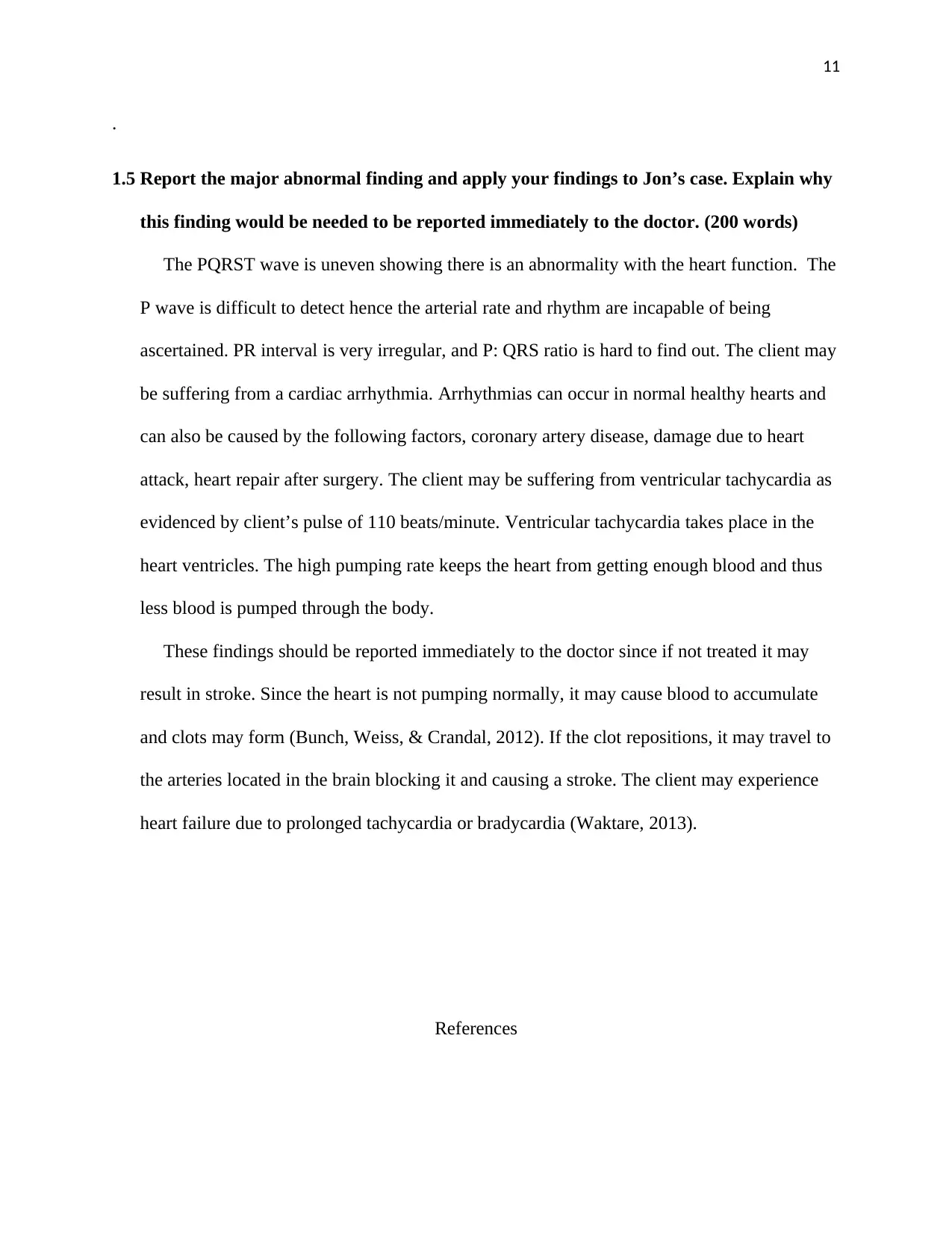
11
.
1.5 Report the major abnormal finding and apply your findings to Jon’s case. Explain why
this finding would be needed to be reported immediately to the doctor. (200 words)
The PQRST wave is uneven showing there is an abnormality with the heart function. The
P wave is difficult to detect hence the arterial rate and rhythm are incapable of being
ascertained. PR interval is very irregular, and P: QRS ratio is hard to find out. The client may
be suffering from a cardiac arrhythmia. Arrhythmias can occur in normal healthy hearts and
can also be caused by the following factors, coronary artery disease, damage due to heart
attack, heart repair after surgery. The client may be suffering from ventricular tachycardia as
evidenced by client’s pulse of 110 beats/minute. Ventricular tachycardia takes place in the
heart ventricles. The high pumping rate keeps the heart from getting enough blood and thus
less blood is pumped through the body.
These findings should be reported immediately to the doctor since if not treated it may
result in stroke. Since the heart is not pumping normally, it may cause blood to accumulate
and clots may form (Bunch, Weiss, & Crandal, 2012). If the clot repositions, it may travel to
the arteries located in the brain blocking it and causing a stroke. The client may experience
heart failure due to prolonged tachycardia or bradycardia (Waktare, 2013).
References
.
1.5 Report the major abnormal finding and apply your findings to Jon’s case. Explain why
this finding would be needed to be reported immediately to the doctor. (200 words)
The PQRST wave is uneven showing there is an abnormality with the heart function. The
P wave is difficult to detect hence the arterial rate and rhythm are incapable of being
ascertained. PR interval is very irregular, and P: QRS ratio is hard to find out. The client may
be suffering from a cardiac arrhythmia. Arrhythmias can occur in normal healthy hearts and
can also be caused by the following factors, coronary artery disease, damage due to heart
attack, heart repair after surgery. The client may be suffering from ventricular tachycardia as
evidenced by client’s pulse of 110 beats/minute. Ventricular tachycardia takes place in the
heart ventricles. The high pumping rate keeps the heart from getting enough blood and thus
less blood is pumped through the body.
These findings should be reported immediately to the doctor since if not treated it may
result in stroke. Since the heart is not pumping normally, it may cause blood to accumulate
and clots may form (Bunch, Weiss, & Crandal, 2012). If the clot repositions, it may travel to
the arteries located in the brain blocking it and causing a stroke. The client may experience
heart failure due to prolonged tachycardia or bradycardia (Waktare, 2013).
References
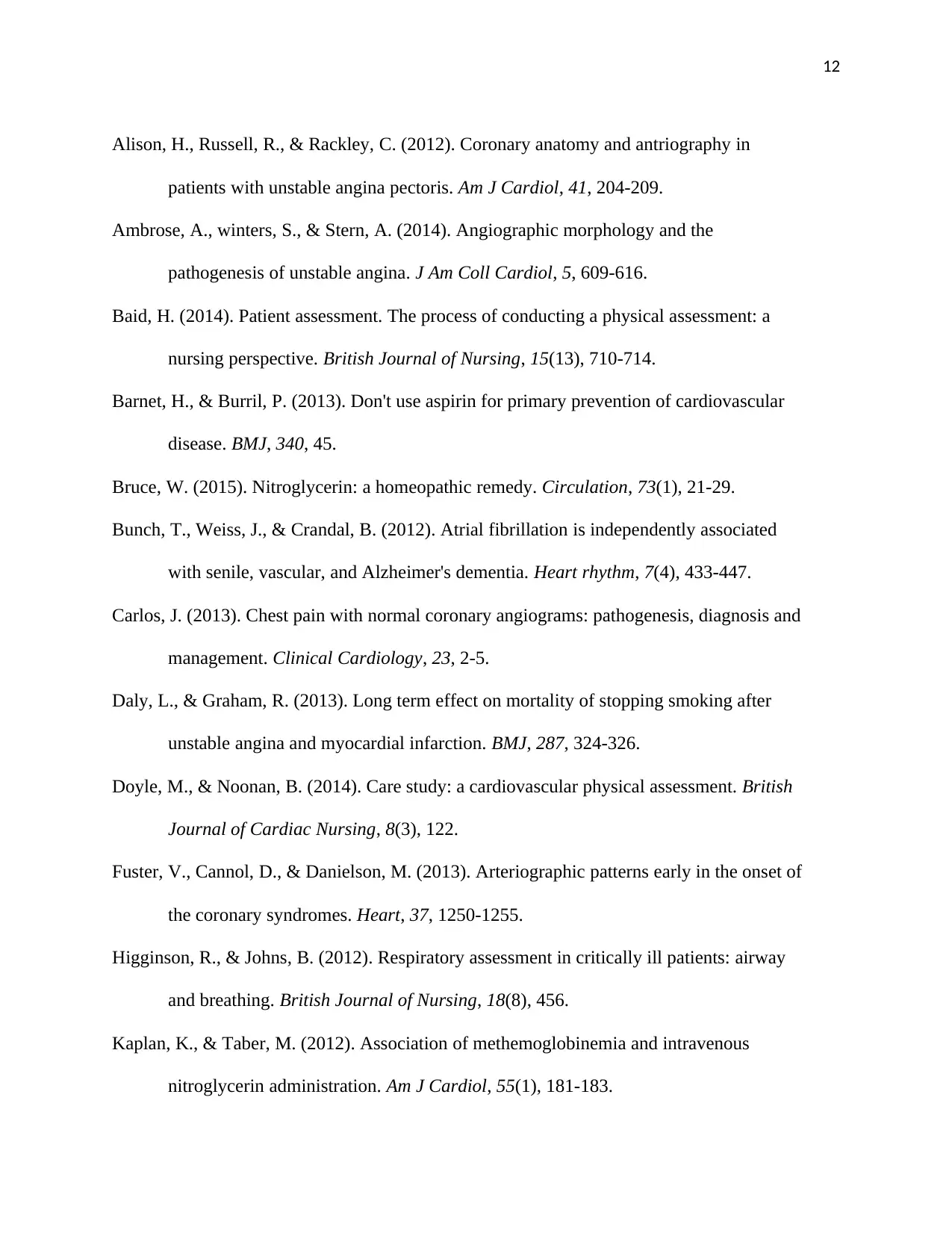
12
Alison, H., Russell, R., & Rackley, C. (2012). Coronary anatomy and antriography in
patients with unstable angina pectoris. Am J Cardiol, 41, 204-209.
Ambrose, A., winters, S., & Stern, A. (2014). Angiographic morphology and the
pathogenesis of unstable angina. J Am Coll Cardiol, 5, 609-616.
Baid, H. (2014). Patient assessment. The process of conducting a physical assessment: a
nursing perspective. British Journal of Nursing, 15(13), 710-714.
Barnet, H., & Burril, P. (2013). Don't use aspirin for primary prevention of cardiovascular
disease. BMJ, 340, 45.
Bruce, W. (2015). Nitroglycerin: a homeopathic remedy. Circulation, 73(1), 21-29.
Bunch, T., Weiss, J., & Crandal, B. (2012). Atrial fibrillation is independently associated
with senile, vascular, and Alzheimer's dementia. Heart rhythm, 7(4), 433-447.
Carlos, J. (2013). Chest pain with normal coronary angiograms: pathogenesis, diagnosis and
management. Clinical Cardiology, 23, 2-5.
Daly, L., & Graham, R. (2013). Long term effect on mortality of stopping smoking after
unstable angina and myocardial infarction. BMJ, 287, 324-326.
Doyle, M., & Noonan, B. (2014). Care study: a cardiovascular physical assessment. British
Journal of Cardiac Nursing, 8(3), 122.
Fuster, V., Cannol, D., & Danielson, M. (2013). Arteriographic patterns early in the onset of
the coronary syndromes. Heart, 37, 1250-1255.
Higginson, R., & Johns, B. (2012). Respiratory assessment in critically ill patients: airway
and breathing. British Journal of Nursing, 18(8), 456.
Kaplan, K., & Taber, M. (2012). Association of methemoglobinemia and intravenous
nitroglycerin administration. Am J Cardiol, 55(1), 181-183.
Alison, H., Russell, R., & Rackley, C. (2012). Coronary anatomy and antriography in
patients with unstable angina pectoris. Am J Cardiol, 41, 204-209.
Ambrose, A., winters, S., & Stern, A. (2014). Angiographic morphology and the
pathogenesis of unstable angina. J Am Coll Cardiol, 5, 609-616.
Baid, H. (2014). Patient assessment. The process of conducting a physical assessment: a
nursing perspective. British Journal of Nursing, 15(13), 710-714.
Barnet, H., & Burril, P. (2013). Don't use aspirin for primary prevention of cardiovascular
disease. BMJ, 340, 45.
Bruce, W. (2015). Nitroglycerin: a homeopathic remedy. Circulation, 73(1), 21-29.
Bunch, T., Weiss, J., & Crandal, B. (2012). Atrial fibrillation is independently associated
with senile, vascular, and Alzheimer's dementia. Heart rhythm, 7(4), 433-447.
Carlos, J. (2013). Chest pain with normal coronary angiograms: pathogenesis, diagnosis and
management. Clinical Cardiology, 23, 2-5.
Daly, L., & Graham, R. (2013). Long term effect on mortality of stopping smoking after
unstable angina and myocardial infarction. BMJ, 287, 324-326.
Doyle, M., & Noonan, B. (2014). Care study: a cardiovascular physical assessment. British
Journal of Cardiac Nursing, 8(3), 122.
Fuster, V., Cannol, D., & Danielson, M. (2013). Arteriographic patterns early in the onset of
the coronary syndromes. Heart, 37, 1250-1255.
Higginson, R., & Johns, B. (2012). Respiratory assessment in critically ill patients: airway
and breathing. British Journal of Nursing, 18(8), 456.
Kaplan, K., & Taber, M. (2012). Association of methemoglobinemia and intravenous
nitroglycerin administration. Am J Cardiol, 55(1), 181-183.
⊘ This is a preview!⊘
Do you want full access?
Subscribe today to unlock all pages.

Trusted by 1+ million students worldwide
1 out of 14
Related Documents
Your All-in-One AI-Powered Toolkit for Academic Success.
+13062052269
info@desklib.com
Available 24*7 on WhatsApp / Email
![[object Object]](/_next/static/media/star-bottom.7253800d.svg)
Unlock your academic potential
Copyright © 2020–2025 A2Z Services. All Rights Reserved. Developed and managed by ZUCOL.





